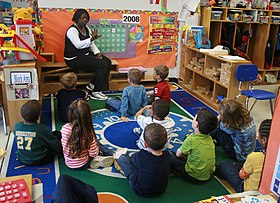
| This article is part of a series on |
| Education in the United States |
|---|
| Summary |
| Curriculum topics |
| Education policy issues |
| Levels of education |
|
|
Primary education in the United States (also called elementary education) refers to the first seven to nine years[1][2] of formal education in most jurisdictions,[3] often in elementary schools, including middle schools. Preschool programs, which are less formal and usually not mandated by law, are generally not considered part of primary education. The first year of primary education is commonly referred to as kindergarten and begins at or around age 5 or 6. Subsequent years are usually numbered being referred to as first grade, second grade, and so forth. Elementary schools normally continue through sixth grade,[4] which the students normally complete when they are age 11 or 12. Some elementary schools graduate after the 4th or 5th grade and transition students into a middle school.
In 2016, there were 88,665 elementary schools (66,758 public and 21,907 private) in the United States.[5]
- ^ "Fast Facts". Nces.ed.gov. Retrieved 2013-12-16.
- ^ "Digest of Education Statistics, 2015 - Chapter 1: All Levels of Education". nces.ed.gov.
- ^ "Comparative Indicators of Education in the United States and Other G8 Countries: 2004" (PDF). U.S. Department of Education Institute of Education Sciences. Retrieved 2010-05-05.
- ^ Aud, Susan; Statistics, National Center for Education; (U.S.), Institute of Education Sciences; Nachazel, Thomas; Wilkinson-Flicker, Sidney; Dziuba, Allison (18 November 2013). The Condition of Education 2013. Government Printing Office. ISBN 9780160920707 – via Google Books.
- ^ "Number of educational institutions, by level and control of institution". Nces.ed.gov. Retrieved December 10, 2019.